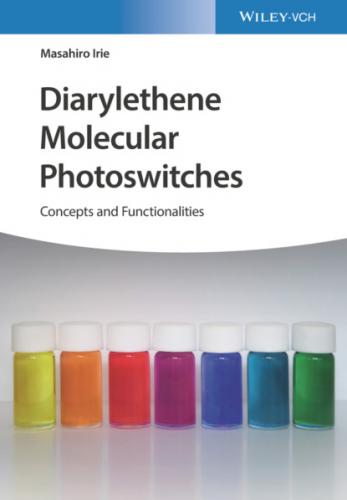The ring‐opening reaction takes place as follows. Upon irradiation with visible light, the closed‐ring isomer is excited to the allowed 1B Frank–Condon state (1BFC(c)). The excited wavepacket moves away from the Frank–Condon region along the 1B surface and rapidly falls from the 1B to 2A surface via a conical intersection (1B/2ACI(c)). The molecule excited with light of shorter wavelengths having vibrational excess energy on the 2A surface goes over the energy barrier 2ATS1 more readily and reaches 2A/1A conical intersection (2A/1ACI(o)). The conical intersection is reached via vibrations orthogonal to the initial motion in the valley. At the conical intersection, fast deactivation to the ground state takes place and thus the open‐ring isomer is formed. The route suggests that thermal activation or excess kinetic energy on the 2A surface is required for the ring‐opening reaction to take place. This agrees with experimental observation that the ring‐opening reaction has an activation energy and that the quantum yield increases upon irradiation with light of shorter wavelengths (see Section 3.1.3) [7, 8].
2.3.1 Cyclization Reaction
As discussed in the theoretical study in Section 2.2, diarylethenes are anticipated to undergo very fast ring‐closing (cyclization) reactions. The rapid cyclization dynamics was confirmed using femtosecond absorption spectroscopies in solution as well as in the single crystalline phase [9].
The cyclization reaction of 1,2‐bis(2,4‐dimethyl‐5‐phenyl‐3‐thienyl)perfluoro‐cyclopentene (5) was investigated in the single crystalline phase. In solution, the open‐ring isomer has two conformations, photoactive antiparallel and photoinactive parallel ones, as shown in Scheme 2.4. Coexistence of the two conformations in solution prevents clear resolution of spectral features associated with the photocyclization reaction. On the other hand, in the single crystalline phase of 5o, all molecules are fixed in the photoactive antiparallel conformation and this simplifies the analysis of reaction dynamics.
Scheme 2.4 A diarylethene open‐ring isomer has two conformations with two aryl groups in mirror symmetry and C2 symmetry, which are called parallel and antiparallel conformations, respectively.
Figure 2.9 shows the transient absorption spectra associated with the cyclization reaction in the single crystalline phase upon irradiation with a 343 nm femtosecond laser pulse. The formation of the spectrum ascribed to the closed‐ring isomer is clearly observed. After approximately 20 ps, the transient spectrum is essentially fully converged to that of the final product. The subpicosecond dynamics following excitation with a 343 nm pulse indicates that the initially broad photoinduced absorption seen at 75 fs progressively shifts from the red (635 nm) to the blue (480 nm) end of the visible spectrum in the first 500 fs following the UV excitation. The progressive spectral shift occurs prior to the ring‐closure itself and is attributed to the evolution on the excited state potential of the open‐ring isomer due to the difference in the equilibrium geometry between ground and excited states. The absorption band at 635 nm is assigned to the excited state absorption of the open‐ring isomer initially in the equilibrium geometry associated with ground state charge distribution. The absorption in the blue end is associated with the relaxed structure of the open‐ring isomer in the excited state. The formation of this intermediate occurs with a time constant of 200 fs.
Figure 2.9 Transient absorption spectra of 5 during the ring‐closing reaction in the single crystal excited with a 343 nm femtosecond laser pulse. Selected spectra for various time delays between −200 fs and +50 ps (black curves), as compared to their associated τ∞ measurements (blue curves). The 100‐fs spectrum was extracted from a separated data set taken with higher resolution time steps.
Source: Adapted with permission from Ref. [9]. Copyright 2011 American Chemical Society.
Figure 2.10a shows the convergence on the picosecond time scale of the transient absorption toward that of the closed‐ring photoproduct. Initially, at 0.5 ps after the pulse the absorption associated with the relaxed open‐ring isomer in the excited state dominates the signal. In the time delay between 0.5 and 20 ps, the spectral feature associated with the intermediate decays in concert with the growth of the ground state absorption associated to the closed‐ring isomer centered at 635 nm. Figure 2.10b shows the transient time traces at 490 and 635 nm. The latter is the central wavelength of the absorption associated with ground state absorption of the closed‐ring isomer and follows the growth of the photoproduct. The former follows the decay of the excited state absorption associated with the relaxed open‐ring isomer. The time constants for the rise at 635 nm and the decay at 490 nm are 7.3 ± 0.8 and 5.3 ± 0.3 ps, respectively. It was anticipated that the rise and decay of the signals would be equally matched, as the closed‐ring photoproduct is thought to be directly formed from the relaxed excited state of the open‐ring isomer through the conical intersection. The discrepancy in the time constants is attributed to the vibrational relaxation of the nascent closed‐ring isomer. The growth of the signal at 635 nm is the convolution of the cyclization reaction, vibrational cooling and lattice relaxation. Therefore, the decay of the excited absorption of the open‐ring isomer is assigned to the time constant of the ring‐closing (cyclization) reaction, that is 5.3 ± 0.3 ps. The cyclization time constant in the single crystalline phase is slightly slower than the values in solution, ∼ subpicoseconds. This is presumably attributed due to the impeding influence of the close‐packed environment in crystal.
Figure 2.10 Transient absorption spectra of 5 during the ring‐closing reaction in the single crystal excited with a 343 nm femtosecond laser pulse. (a) Transient absorption spectra for time delay between 0.5 and 50 ps. (b) Transient traces for the probe wavelengths at 635 and 490 nm. Monoexponential
